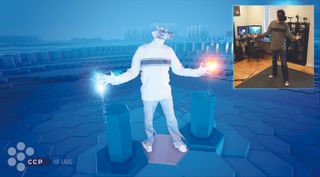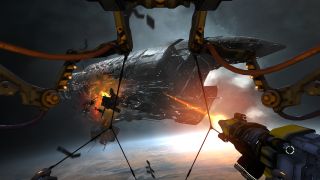Hands-on with CCP's new VR prototypes

A disembodied voice is telling me to look down at my hands. I do, and yes, there they are. At least, there's the surreal holographic light they're now made of. Now I'm being asked if I can see the CCP representative stood next to me. Again, I can. She's a surreal holographic light, too. She extends her hand, and I shake it—my real hand grasping her real hand as my virtual one grasps her virtual one. Her hand turns green as if acknowledging that, oh shit son, we're in the future now.
CCP's Atlanta studio has been tasked with prototyping a series of VR experiments. The hope is to stumble across another Eve: Valkyrie—a tech demo that proves so popular that it's greenlit into a full game. Shaking a CCP employee's hand is not the prototype, it's just the orientation process that precedes it.
To explain: I'm standing in the Fanfest demo area with an Oculus DK2 on my face. In front of the Oculus is a Kinect 2.0, and CCP is combining the two to create VR demos that let you make use of your body in the virtual space. Around me are other demo stations, and showing me that I can see and interact with the real world lets me feel safe in performing the actions required in the virtual one. It's a lot like how I imagine HTC's Vive works, and CCP acknowledges that SteamVR would let them sidestep the show floor's homebrew set-up.
The Workshop
In all, it's a great effect and, for the most part, feels intuitive to use. Menus are opened by pointing at a distant circle, and swiping across the radial menu that's triggered. Other objects are equally simple to manipulate. The Workshop demo is a compilation of VR toys. It contains boxes you can kick over, and fireballs that you can grab and throw at distant targets. The fireballs are the most 'gamey' part of the demo. They hover on plinths, and jump into my hand when I swipe past them. They're thrown exactly like you'd throw a real ball—flying out in response to an overarm bowl or flick of the wrist. The only difference is that they explode on impact.
The most startling part of the demo isn't fireballs, but maps. One section of The Workshop is a 3D hex-based map of Iceland. I can move my hand over the map, pushing down the hexes as I hover over them. It's a simple enough idea, but one that tricks my brain into thinking I'm touching a real object. As I move over the map, I get a tingling in my hand—not as if I'm feeling anything real, but as if my brain wants to provide the impulse of touching something because it can see me touching something and is very, very confused.
Disc Arena
The biggest gaming news, reviews and hardware deals
Keep up to date with the most important stories and the best deals, as picked by the PC Gamer team.
Another demo, Disc Arena, isn't quite so revelatory. It's a Tron style multiplayer game in which me and an opponent are flinging neon discs at one another. My right hand lights up when I can throw a disc, and my left hand contains a translucent shield that I can use to bat away my opponent's projectiles.
It's a solid idea, but basic. The discs travel too slowly to require anything more than the occasional interaction, and we both quickly learn that rebounding off walls is both the key to success and slightly annoying to deal with. Also, thanks to the Tron inspiration, it feels a little bit tacky—like how you expected VR to be based on TV and film made around the last time the technology reared its head.

Project Nemesis
Also on the floor was CCP Shanghai's experiment. It's not technically a "PC" game—instead, it uses Samsung's Gear VR device. Essentially, it's a mobile phone strapped to a headset that's strapped to your face. The upside is it's entirely standalone, and doesn't need to be plugged into a stationary device. The downside is their game, Project Nemesis, feels restrained by the technology.
It's an Unreal Engine 4 on-rails shooter, in which I blast ships by looking at them and tapping the device on my head. It's fine, and there are some neat idea in a final boss fight that requires me to grab debris to shield myself from turret attacks.
Ship Spinner
Much more promising is CCP Atlanta's Ship Spinner, which instantly makes sense—not so much as a game, but as an interactive gallery that would be attractive to Eve Online's playerbase. I'm back in the Oculus DK2/Kinect combo, and positioned in front of a 3D model of a ship that I can raise and spin with my hands. It's like the holographic computer in Iron Man, only space ships.
I peer my head head forward and can see inside this space diorama. Rooms light up, machinery activates, and little men and women stand around oblivious to the intrusive giant peering through their walls. There's some basic interactivity, too. I can order the ship to shoot at a distant asteroid, and instruct drones to deploy. As the small robots buzz about my head, I can swat at them like flies, causing them to explode. It's a fun gimmick that adds some personality to what is otherwise a virtual museum piece.
It's also the most unintuitive of demos—a fact due to the fact is in development up until the weekend before Fanfest. It's still early days and so hard to tell if any of these prototypes will come to anything, but Ship Spinner felt the strongest conceptually.

Phil has been writing for PC Gamer for nearly a decade, starting out as a freelance writer covering everything from free games to MMOs. He eventually joined full-time as a news writer, before moving to the magazine to review immersive sims, RPGs and Hitman games. Now he leads PC Gamer's UK team, but still sometimes finds the time to write about his ongoing obsessions with Destiny 2, GTA Online and Apex Legends. When he's not levelling up battle passes, he's checking out the latest tactics game or dipping back into Guild Wars 2. He's largely responsible for the whole Tub Geralt thing, but still isn't sorry.
Most Popular

